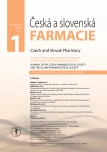Složení aminokyselin a sacharidů v nati a kořenech Smallanthus sonchifolius
Authors:
Olga V. Demeshko 1; Elena V. Krivoruchko 1; Victoria I. Volochai 1; Victoria A. Samoilova 1; Vladimir V. Kovalev 2
Authors‘ workplace:
National University of Pharmacy, Department of Pharmacy, str. Valentynivska 4, 61168 Kharkiv, Ukraine
1; National University of Pharmacy, Department of Technology of Drug, Kharkiv, Ukraine
2
Published in:
Čes. slov. Farm., 2020; 69, 48-51
Category:
Short communication
Overview
Složení volných a v proteinech vázaných aminokyselin bylo analyzováno metodou HPLC v nati a kořenech Smallanthus sonchifolius. V nati jakonu bylo stanoveno čtrnáct volných a patnáct vázaných aminokyselin, v kořenu tři volné a čtrnáct v proteinech vázaných aminokyselin. V nati mezi volnými aminokyselinami dominoval prolin (0,44 µg/mg) a kyselina asparagová (0,12 µg/mg), v kořenech potom prolin (0,28 µg/mg). Mezi vázanými aminokyselinami v nati převažovala kyselina asparagová (18,58 µg/mg), kyselina glutamová (16,33 µg/mg) a prolin (14,52 µg/mg), v kořenech se jednalo zejména o prolin (3,14 μg/mg). V nati S. sonchifoli byly s použitím plynové chromatografie spojené s hmotnostní spektrometrií (GC-MS) identifikovány fruktosa, sacharosa a arabinosa ve volné formě. Z natě jakonu byl získán polysacharidový komplex a jeho výtěžek činil 5,13 ± 0,09 %. Fruktosa (3,11 µg/mg) byla jediným monosacharidem identifikovaným v hydrolyzátu získaného komplexu.
Klíčová slova:
Smallanthus sonchifolius (jacon) – aminokyseliny – sacharidy – metody GC-MS HPLC
Sources
1. Cho N., Shaw J. E., Karuranga S., Huang Y., da Rocha Fernandes J. D., Ohlrogge A. W., Malanda B. IDF Diabetes Atlas: Global estimates of diabetes prevalence for 2017 and projections for 2045. Diabetes Res. Clin. Pract. 2018; 138, 271–281.
2. Valentová K., Stejskal D., Bartek J., Dvořáčková S., Křen V., Ulrichová, J., Šimánek V. Maca (Lepidium meyenii) and yacon (Smallanthus sonchifolius) in combination with silymarin as food supplements: in vivo safety assessment. Food Chem. Toxicol. 2008; 46(3), 1006–1013.
3. Baroni S., da Rocha B. A., de Melo J. O., Comar J. F., Caparroz-Assef S. M., Bersani-Amado C. A. Hydroethanolic extract of Smallanthus sonchifolius leaves improves hyperglycemia of streptozotocin induced neonatal diabetic rats. Asian Pac. J. Trop. Med. 2016; 9(5), 432–436.
4. Sousa S., Pinto J., Pereira C., Malcata F. X., Pacheco M. B., Gomes A. M., Pintado M. In vitro evaluation of yacon (Smallanthus sonchifolius) tuber flour prebiotic potential. Food Bioprod. Process. 2015; 95, 96–105.
5. Sousa S., Pinto J., Rodrigues C., Gião M., Pereira C., Tavaria F., Malcata F. X., Gomes A., Bertoldo Pacheco M. T., Pintado M. Antioxidant properties of sterilized yacon (Smallanthus sonchifolius) tuber flour. Food Сhem. 2015; 188, 504–509.
6. Carlsen M. H., Halvorsen B. L., Holte K., Bøhn S. K., Dragland S., Sampson L., Barikmo I. The total antioxidant content of more than 3100 foods, beverages, spices, herbs and supplements used worldwide. Nutr. J. 2010; 9(1), 3.
7. Tokiko Mizuno, Koji Yamada. Free amino acid composition in the root of Yacon (Smallanthus sonchifolius). J. Integr. Stud. Diet. Habit. 2007; 18(3), 283–287.
8. Lachman J., Fernández E. C., Orsák M. Yacon (Smallanthus sonchifolius (Poepp. et Endl.) H. Robinson) chemical composition and use-a review. Plant Soil Environ. 2003; 49(6), 283–290.
9. Demeshko O. V, Krivoruchko E. V, Samoilova V. A, Romanova S. V. Gas chromatography – mass spectrometry studies of the component composition of carboxylic acids of the herb and roots crops of Smallanthus sonchifolius. Ces. slov. Farm. 2018; 67(4), 160–163.
10. Demeshko O. V, Kovalyov V. N, Kovalyov S. V. The study of amino acid composition in the herb of Оnobrychis arenaria. Ukr. Biopharm. J. 2015; 2, 75–78.
11. Henderson J. W., Ricker R. D., Bidlingmeyer B. A., Woodward C. Agilent1100 HPLC. Technic. Note 1999; 5980(1193E), 10.
12. Molnár-Perl I. Advancement in the derivatizations of the amino groups with the o-phthaldehyde-thiol and with the 9-fluorenylmethyloxycarbonyl chloride reagents. J. Chromatogr. B. 2011; 879(17–18), 1241–1269.
13. Jambor A., Molnar-Perl I. Quantitation of amino acids in plasma by high performance liquid chromatography: simultaneous deproteinization and derivatization with 9-fluorenylmethyloxycarbonyl chloride study. J. Chromatogr. A. 2009; 1216(34), 6218–6223.
14. Karpyuk U. V., Kislichenko V. S., Gur’eva I. G. HPLC Determination of free and bound amino acids in Bryonia alba. Chem. Nat. Compd. 2015; 51(2), 399–400.
15. Otter D. E. Standardised methods for amino acid analysis of food. Br. J. Nutr. 2012; 108(2), 230–237.
Labels
Pharmacy Clinical pharmacologyArticle was published in
Czech and Slovak Pharmacy

2020 Issue 1
Most read in this issue
- Komplexy kovov v medicíne a farmácii – minulosť a súčasnosť II*
- Farmakokinetické aspekty terapie beta-laktamovými antibiotiky u kriticky nemocných pacientů: Zkušenosti jednoho centra s TDM
- Výzkum kompatibility kyseliny thioktové, magnesium-stearátu a pyridoxin-hydrochloridu
- Zomrel Alois Borovanský
